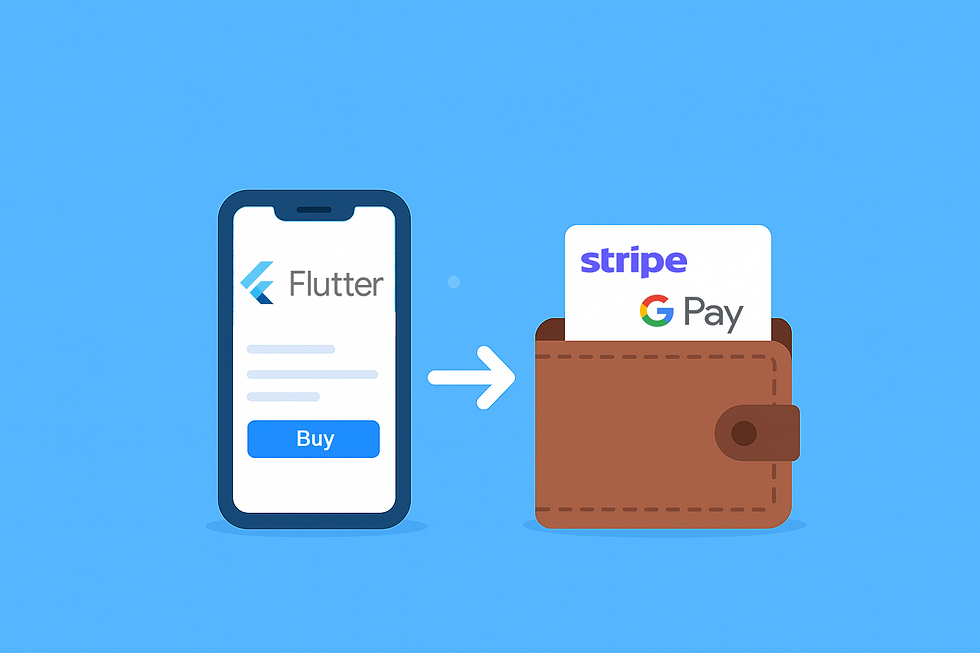Streamlining Payments in Flutter: Stripe, Google Pay, and Custom Checkout
- Maksim Murin
- Sep 9
- 6 min read
In today’s mobile applications 📱, implementing a smooth and secure payment flow 💳 is no longer a “nice to have” – it’s a fundamental part of the user experience. Whether we sell digital subscriptions📚, online courses 🎓, or physical products 📦, users expect to pay directly inside the app with just a few taps.

Flutter makes it incredibly easy ✨ to build beautiful cross-platform apps. But sooner or later, most real projects run into the same problem – taking payments. As soon as money is involved 💰, a normal UI screen is no longer enough. We immediately have to think about security, regulations, fraud protection and user experience.
This is where Stripe becomes the perfect match.
Why Stripe and Google Pay?
When building a payment system, choosing the right tools is crucial. Customers want a process that feels fast, secure, and effortless, while businesses look for solutions that are scalable, compliant, and easy to maintain. This is where Stripe and Google Pay come together as a powerful combination.

Stripe is one of the most trusted payment platforms worldwide. It handles transactions securely, supports various business models from one-time purchases to subscriptions, and offers PCI compliance and advanced fraud protection. Developers appreciate its well-documented APIs and easy integration, while businesses value the reliability it brings.
Stripe allows you to:
accept payments without handling any card data
create payment attempts (called PaymentIntents)
confirm a payment directly in the Flutter application
use popular wallets like Google Pay as part of the payment flow
Google Pay adds convenience for Android users. Customers can complete purchases with a single tap, without entering card details, using a system they already know and trust. This smooth checkout reduces friction and lowers the risk of abandoned carts, improving conversion rates.
Together, Stripe and Google Pay give businesses the best of both worlds: secure, compliant processing plus a seamless, familiar user experience – exactly what today’s customers expect.
Demo Application Overview
Rather than just talking about payment systems in theory, we wanted to show how they look and feel in practice. To do this, we created a small demo app in Flutter with a very straightforward goal: letting users “purchase” online courses.

The app keeps things simple so the focus stays on the payment experience itself. On the main screen, there are three clear options: using the Stripe Payment Sheet, completing a purchase with Google Pay, or entering details through a custom payment form. Each path represents a different checkout style, and together they highlight how flexible and user-friendly a payment system can be when built with Flutter.
Stripe Payment Sheet – the all-in-one solution that pops up with a polished, ready-to-use interface. It supports cards, Google Pay, and Apple Pay (on iOS). For businesses, this is the easiest path to a professional checkout flow without reinventing the wheel.
Google Pay button – a direct integration that skips extra steps. Many users already have their cards saved in Google Pay, so this makes checkout nearly instant. Tapping this button brings up the familiar Google Pay interface and lets customers confirm the purchase with just one click.
Custom form – our experiment with flexibility. Here, the user enters card details manually in a tailored UI. While this requires more work (and Stripe still handles the sensitive parts behind the scenes), it gives full control over the design, which might be valuable for businesses seeking a branded checkout experience.
High-Level Implementation
Building a secure payment system is more than just adding a checkout button. Multiple components work behind the scenes, each with a specific role, ensuring a seamless experience for the customer while keeping sensitive data safe.
In our demo, the Flutter app is the customer-facing interface. It shows available courses and payment options, but never handles sensitive financial data directly – doing so would be risky and complex. Instead, the app simply lets users make their choices while the secure processing happens behind the scenes.
Whenever a user initiates a payment, the app talks to a server component. In our case, we used a lightweight server built with Dart, though in a real business scenario this could be any backend technology. The server’s job is crucial: it communicates with Stripe, creates a payment request on behalf of the app, and ensures that all sensitive operations (like dealing with API keys or verifying amounts) happen in a secure environment. This way, the mobile app stays simple, and the heavy lifting is handled in the background.

On the payment side, Stripe provides the backbone of the system. It takes care of securely processing the transaction, managing compliance requirements, and offering tools to handle everything from one-time purchases to recurring subscriptions. Google Pay, in turn, adds convenience for Android users by letting them complete their purchase instantly with a single tap, using payment details already saved in their device.
The payment flow works seamlessly thanks to the collaboration of several components: the customer interacts with the Flutter app, which requests payment details from the server. The server then prepares the transaction via Stripe, and the customer completes the payment using Stripe’s payment sheet, Google Pay, or a custom form. To the user, it all feels smooth and effortless, while behind the scenes each part ensures the checkout is secure and reliable.
Payments in Flutter Technical Deep Dive
Preparing the Project
Before diving into payments, we first needed to set up our Flutter project with the right dependencies and permissions. The goal was simple: make sure the app can talk to Stripe and display Google Pay as a native option.
On the Flutter side, this started with adding the official flutter_stripe package. It brings in everything needed to present the Payment Sheet, handle cards securely, and link back to Stripe’s APIs.
For Google Pay integration on Android, there were a couple of additional steps. First, the app’s manifest had to be updated with the right permissions and metadata so that the system even recognizes Google Pay as available. Then, a configuration file (gpay.json) was added under the assets. This file essentially tells Google Pay what card networks and authentication methods are supported, and how to route the payment through Stripe.
With these pieces in place, Google Pay shows up as a native payment option in the app, alongside traditional card entry – which makes the checkout experience smoother and more familiar to users.
Backend Setup (Dart Server)
When it comes to payments, security is the number one priority. That’s why we can’t just let the mobile app talk directly to Stripe with secret keys – those keys should never leave a secure server. Instead, the app asks our backend to do the sensitive work, and the backend returns only the information the app needs to continue.

For our demo, we kept things lightweight by using a Dart server. It handles a single but very important job: creating a Payment Intent with Stripe. This intent is like a placeholder that tells Stripe “we’re about to process a payment of X amount for Y currency.” Once created, Stripe gives back a special identifier (called a client_secret), which the mobile app can safely use to complete the payment.
On the client side, the Flutter app ties everything together and gives users a checkout flow that feels both simple and secure. The backend stays responsible for sensitive operations, while the app itself focuses on presenting clear payment options and handing off the right data to Stripe or Google Pay.
Stripe SDK integration – The app initializes the flutter_stripe package with the publishable key. This is what unlocks the Payment Sheet and secure card handling inside Flutter. Importantly, the client never touches raw card details – they’re routed straight to Stripe.
Centralized Payment Service – To keep the UI clean, all payment logic is wrapped in a PaymentService class. This service tracks states like processing, success, failure, and cancellation, and exposes a straightforward API for triggering either Google Pay, Stripe Payment Sheet, or a custom card flow. Developers only call PaymentService methods, while the messy details of interacting with Stripe are hidden inside.
To make development and testing easier, we enabled the Google Pay API test cards allowlist. This feature lets developers simulate real transactions with test card numbers, so payments can be verified safely without charging actual money.
Together, these approaches showcase the flexibility of Flutter in handling multiple payment flows: ready-made checkout, native wallet integration, and fully custom UI. This layered strategy gives businesses the freedom to choose the best experience for their users while maintaining security and compliance.
📂 Full project source code is available below.
Conclusion
Building a payment system often means finding the right balance ⚖️ between simplicity for users and strict security requirements. Flutter and Stripe help strike this balance 🤝 without adding unnecessary complexity.
For businesses, modern checkout flows are more than just a technical feature – they shape the customer experience. A smooth, secure process builds confidence, reduces friction, and leads to higher conversion rates 📈.
While this demo focused on course purchases, the same architecture can be adapted for subscriptions, donations, or marketplaces. With Flutter’s flexibility and Stripe’s robust infrastructure, scaling digital products becomes far more approachable 🚀.
In short: secure, user-friendly payments are not only possible с they’re practical.
Let’s Build Smarter Payments Together
At Igniscor, we go beyond standard Flutter development – we create seamless payment experiences with Stripe and Google Pay integration. From secure transactions to smooth user flows, we combine cross-platform flexibility with native performance to deliver reliable and scalable solutions.
Got a project in mind? Let’s make it happen – contact us today! 🚀






Comments